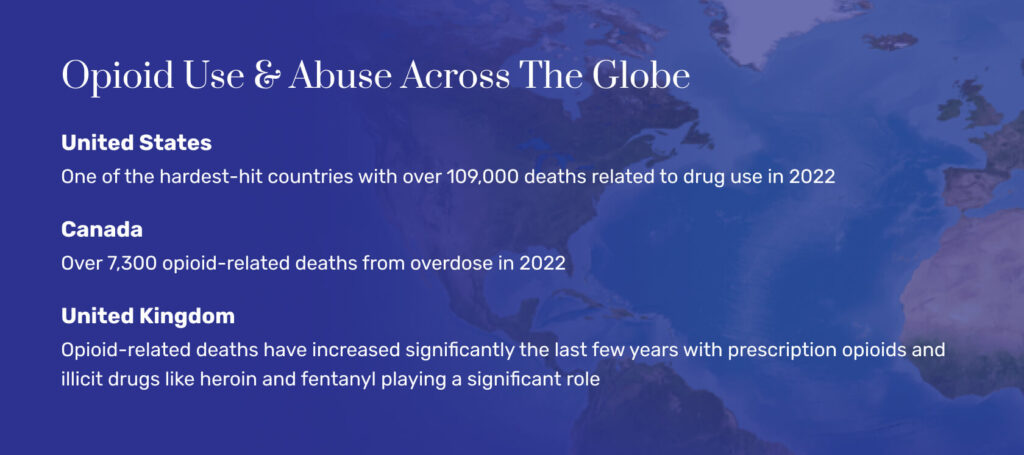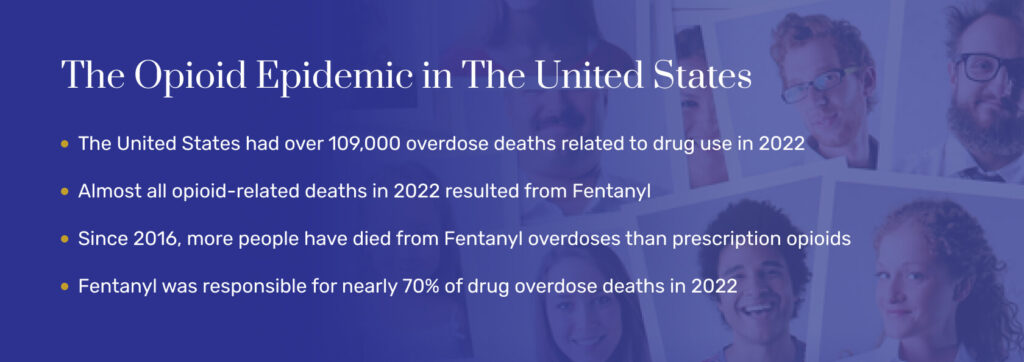Know that people with an opioid addiction can recover. Entering a science-based treatment program increases the odds of a persistent recovery. However, hard stats are difficult to come by.
Key Facts
Key Facts
- 1.6 million people had an opioid use disorder in 2019.[2]
- The U.S. Department of Health and Human Services declared opioid abuse a public health emergency in 2017.[2]
- More than 75% of drug overdose deaths in 2021 involved an opioid.[3]
- Opioid relapse rates in people enrolled in treatment programs are higher than 13%.[4]
Opioid Addiction: A Global Issue
Opioid use disorder (OUD) is a huge problem within the United States, but the issue doesn’t stop at the country’s borders. People all around the world struggle with opioid abuse and addiction.
Are you or someone you know struggling with addiction?
I may have a problem I am concerned for a loved oneAn estimated 60 million people used painkillers nonmedically in 2021, and 31.5 million abused opioids like heroin.[5] Of all countries that rank drugs leading to addiction, 31% placed opioids in first place.[5]
Globally, opioids account for 69% of drug overdose deaths.[6] In the United States and Canada, those deaths are typically caused by synthetic opioids like fentanyl. In Africa and Asia, those deaths are caused by nonmedical use of the synthetic opioid tramadol.[6]

Opioid Abuse in the United States
Researchers say 1.6 million Americans had an opioid use disorder in 2019.[2] More than 10 million people misused prescription painkillers, like Vicodin or OxyContin, and 745,000 used heroin.[2]
People who abuse opioids are at high risk of overdose. Unfortunately, the number of overdose deaths is rising.
In 2021, the number of people who died of drug overdose was more than six times the number recorded in 1999.[8] Between 2020 and 2021, opioid-involved death rates increased by more than 15%.[8]

Recovery & Success Rates
An estimated 1.2 million American adults have recovered from an opioid abuse problem.[10] Recovery is possible, but tracking how many people get better (and how many do not) isn’t always easy.
Getting science-based treatment for opioid use disorder increases the chances of success in long-term recovery. In one study, about 33% of people enrolled in a medication-assisted treatment (MAT) program were abstinent from heroin after five years.[11] About 20% were abstinent from all opioids at the five-year mark.[11]
Despite the efficacy of MAT, only about 11% of people with opioid addictions get this treatment.[11] Researchers say a lack of qualified providers, along with stigma about MAT, causes this problem.
Barriers to Recovery: Treatment Access & Better Data
State and federal governments do not track opioid recovery like they track rates of addiction, overdose, and death. Without this information, it can be difficult to know which recovery programs are most effective and which states are providing the right types of medical, financial, and behavioral support to improve the evidence-based recovery process.
Without MAT, ending the body’s opioid dependence can take about 10 days, with the most intense withdrawal symptoms occurring between the third and fifth day.[12] Cravings and psychological withdrawal symptoms may last longer, which increases the risk of relapse. If a person isn’t in a comprehensive addiction treatment program, relapse is highly likely during opioid withdrawal.
Unfortunately, many people who enter addiction treatment do not receive the full course of care they need, either because they cannot afford it or because they drop out for other reasons.
Factors for a Successful Recovery
Everyone is different, as is every path to sobriety. However, many people who overcome opioid addictions share similar characteristics and treatment elements.
A successful recovery from opioid addiction typically involves the following items:
- MAT: An evidence-based program that includes medications like buprenorphine and methadone increases the chance of success in recovery from OUD.[13]
- Therapy: Approaches like cognitive behavioral therapy (CBT) are proven to help people overcome addictions.[14]
- Aftercare: Recovery rates are typically higher in people who stay engaged in therapy through aftercare techniques, like support group meetings and additional therapy sessions.[15]
- Duration of care: Changing a longstanding opioid abuse habit is difficult, and building a new life can take time. Longer times in treatment are correlated to improved long-term recovery rates and lower relapse rates.
A successful recovery program is typically flexible. It changes as people’s needs change. Your treatment team may add or remove elements as needed, depending on your progression in recovery.
Why Relapsing Does Not Mean Failure
Addiction is a chronic condition. For some people, relapse is a part of the recovery process.[16]
A relapse is a return to drug use after an attempt to stop. Relapse rates for drugs are similar to the rates seen in other chronic illnesses like heart disease or diabetes.[16] Each relapse episode gives people important information they can use in the next sobriety attempt.
For example, someone who didn’t use MAT in a treatment program for opioid abuse might relapse due to cravings. They may decide, after a relapse, that MAT is a good next step. A final treatment episode with MAT could result in long-term recovery.
A relapse can be frustrating, especially if you’ve worked really hard in treatment. However, know that a relapse isn’t a personal failure. It’s an opportunity to try something new next time. The end result of long-term recovery from opioid addiction is worth the effort.
- Treatment Episode Data Set (TEDS) 2020. Department of Health and Human Services, Substance Abuse and Mental Health Services Administration. Published October 2022. Accessed November 14, 2023.
- Opioid facts and statistics. U.S. Department of Health and Human Services. Published December 16, 2022. Accessed November 14, 2023.
- Drug overdose deaths. Centers for Disease Control and Prevention. Published August 22, 2023. Accessed November 14, 2023.
- Opioid relapse and its predictors among methadone maintenance patients: A multicenter, cross-sectional study in Vietnam. Nguyen H, Dinh D. Harm Reduction Journal. 2023;20:136.
- Executive summary, World Drug Report 2023. United Nations. Published 2023. Accessed November 14, 2023.
- Facts and stats. International Overdose Awareness Day. Accessed November 14, 2023.
- The burden of drug use disorders. Pan American Health Organization. Published 2021. Accessed November 14, 2023.
- Understanding the opioid overdose epidemic. Centers for Disease Control and Prevention. Published August 8, 2023. Accessed November 14, 2023.
- Opioid addiction. Azadfard M, Huecker M, Leaming J. StatPearls. Published July 21, 2023. Accessed November 14, 2023.
- Recovery From Opioid Problems in the US Population: Prevalence, Pathways, and Psychological Well-Being. Hoffman LA, Vilsaint C, Kelly JF. Journal of Addiction Medicine. 2020;14(3):207-216.
- Medication-Assisted Treatment for Opioid Use Disorder in a Rural Family Medicine Practice. Deyo-Svendsen M, Cabrera Svendsen M, Walker J, Hodges A, Oldfather R, Mansukhani MP. Journal of Primary Care & Community Health. 2020;11:2150132720931720.
- Opioid abuse. American Society of Anesthesiologists. Accessed November 14, 2023.
- Recovery is possible: Treatment for opioid addiction. Centers for Disease Control and Prevention. Published September 2, 2021. Accessed November 14, 2023.
- Cognitive behavioral therapy for substance use disorders. McHugh RK, Hearon BA, Otto MW. Psychiatric Clinics of North America. 2010;33(3):511-525.
- Continuing care research: what we have learned and where we are going. McKay JR. Journal of Substance Abuse Treatment. 2009;36(2):131-145.
- Treatment and recovery. National Institute on Drug Abuse. Published July 2020. Accessed November 14, 2023.




